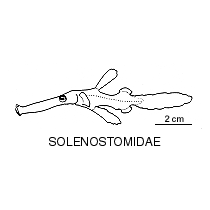- Classification
- ACTINOPTERYGII
- SYNGNATHIFORMES
- SOLENOSTOMIDAE
-
Fish Classification
-
Class
ACTINOPTERYGII Ray-finned fishes -
Order
SYNGNATHIFORMES Seahorses, pipefishes -
Family
SOLENOSTOMIDAE Ghost pipefishes -
Genera
Solenostomus(5)
Family SOLENOSTOMIDAE
More Info
|
Family Taxonomy |
This very small family comprises a single genus, Solenostomus and 4 recognised species, all found in Australian waters. There is considerable variation within the four species. |
|
Family Distribution |
Ghost pipefishes are widespread throughout the tropical Indo-Pacific. They live amongst algae, seagrasses and sessile invertebrates in a variety of habitats ranging from coral reefs to muddy, sandy, seagrass or marine algal substrates from near the surface to 95m. |
|
Family Description |
Meristic features: Dorsal fin V, 16-22; Anal fin 17-22; Pectoral fin 22-28; Pelvic fin I, 6; Caudal fin 15-17; Vertebrae 32-34. Body short, compressed, snout long, tubular, mouth small at snout tip; gill openings moderately large, circumorbital bones absent. Fins high and large; first dorsal fin with long, weak spines, second dorsal fin mounted on a base; pelvic fins large, opposite first dorsal fin, united to form brood pouch in females. Body covered in large segmented ridged, stellate dermal plates which form a bony armour ornamented with filamentous appendages. |
|
Family Size |
Reach a total length of about 17cm. |
|
Family Colour |
Ghostpipefishes are amazingly camouflaged in both colour and body form. |
|
Family Feeding |
Feed by sucking very small invertebrates and zooplankton such as mysids and benthic crustaceans in through their tubular snouts. They may also feed on invertebrates that live on gorgonian corals or crinoids. |
|
Family Reproduction |
The sexes are separate and fertilisation is external. Males and females often live in pairs and at least one species is thought to form monogamous pairs. Unlike seahorses and their relatives, female ghost pipefishes brood their eggs externally in a brood pouch or marsupium, formed from the united pelvic fins. Larval stages are known for two species. At hatching, the larvae are well-developed and about 3 mm in length. They are elongate, compressed, with pigmented eyes and have a fully-formed mouth, a long straight gut, and well-developed body spination. The juveniles of at least one species are reportedly pelagic until they settle out to breed. |
|
Family Commercial |
Ghost pipefishes are occasionally taken as bycatch in bottom trawls, and are keenly sought for sale in the aquarium industry. They are protected in many countries and are very difficult to keep in captivity. |
|
Family Conservation |
Australian Government Legislation: All species are Marine Listed under the Environment Protection and Biodiverity Conservation Act 1999 (EPBC Act). State Government Legislation: Species found in New South Wales are protected under the NSW Fisheries Management Act 1994. |
|
Family Remarks |
Although often found in pairs, ghost pipefishes sometimes live in groups amongst gorgonian branches, floating weeds, coralline algae or crinoids. Species may be short lived, perhaps even having an annual life-cycle. |
|
Author |
Dianne J. Bray |
References
Allen, G.R., R. Steene, P. Humann & N. Deloach. 2003. Reef fish identification: Tropical Pacific. New World Publications, Inc. Jacksonville, FL.
Fishelson, L. 1966. Solenostomus cyanopterus blecker (Teleostei, Solenostomidae) in Elat (Gulf of Akaba). Israel J. Zool. 15: 95–103.
Fritzsche, R.A. & K.G. Thiesfeld. 1999. Family Solenostomidae. (p. 2263) In Carpenter, K.E. & Niem, V.H. (eds) The Living Marine Resources of the Western Central Pacific. FAO Species Identification Guide for Fisheries Purposes. Vol. 4. FAO, Rome.
Kuiter, R.H. 1996. Guide to Sea Fishes of Australia. New Holland Press, Sydney, 433 pp.
Kuiter, R.H. 2003. Seahorses, Pipefish and their Relatives, a comprehensive guide to Syngnathiformes. TCM Publishing, Chorleywood, UK.
Kuiter, R. H. 2009. Seahorses and their relatives. Aquatic Photographics, Seaford, Australia. 333 pp.
Munro, I.S.R. 1958. Handbook of Australian fishes. No. 23. Fish. Newsletter (Aust.) 17(5): (93–96) 17–20, figs. 643–63.
Orr, J.W. & R.A. Fritzsche. 1993. Revision of the ghost pipefishes, family Solenostomidae (Teleostei: Syngnathoidei). Copeia 1993(1): 168–182.
Orr, J.W., R.A. Fritzsche & J.E. Randall. 2002. Solenostomus halimeda, a new species of ghost pipefish (Teleostei: Gasterosteiformes) from the Indo-Pacific, with a revised key to the known species of the family Solenostomidae. Aqua, J. Ichthy. Aquat. Biol. 5(3): 99–108.
Padmanabhan, K.G. 1961. Early development of Solenostomus cyanopterus Blkr. Bull. Centr. Res. Inst., Trivandrum (Series C: Natural Sciences) 8: 1–13.
Paxton, J.R., J.E. Gates, D.J. Bray & D.F. Hoese. 2006. Solenostomidae, In Beesley, P.L. & A. Wells (Eds). Zoological catalogue of Australia. Volume 35 Fishes. ABRS & CSIRO Pulbishing, Australia. Part 2.
Randall, J.E., G.R. Allen. & R.C. Steene. 1997. Fishes of the Great Barrier Reef and Coral Sea. Crawford House Publishing, Bathurst, Australia.
Senou. H. 1994. A review of the ghost pipefishes, genus Solenostomus (Teleostei: Solenostomatidae) from Japan. I.O.P. Diving News 5(6): 2–6.
Trnski, T. & J.M. Leis. 2000. Solenostomidae (Ghost Pipefishes), p. 213–216, In Leis, J.M. & B.M. Carson-Ewart (eds.) The larvae of the Indo-Pacific coastal fishes. An identification guide to marine fish larvae. 1st Ed. Brill, Leiden. 850 pp.
Wetzel, J. & J.P. Wourms (1995). Adaptations for reproduction and development in the skin-brooding ghost pipefishes, Solenostomus. Environmental Biology of Fishes. 44:363-384.
Whiteman, E.A. & I.M. Côté. 2004. Monogamy in marine fishes. Biol. Rev. 79: 351–375.




































